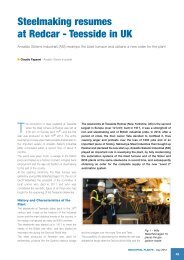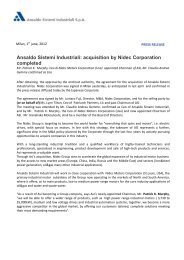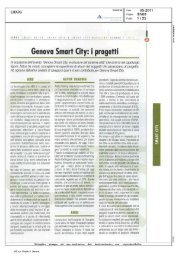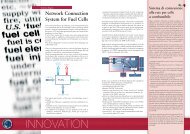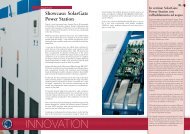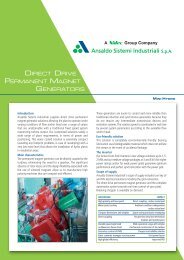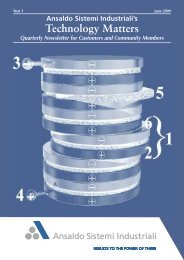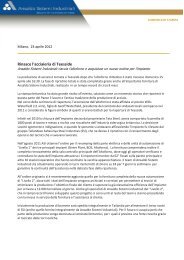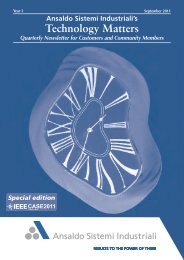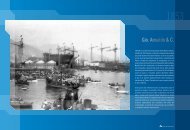Mini - idroelettrico a magneti permanenti - Ansaldo Sistemi Industriali
Mini - idroelettrico a magneti permanenti - Ansaldo Sistemi Industriali
Mini - idroelettrico a magneti permanenti - Ansaldo Sistemi Industriali
You also want an ePaper? Increase the reach of your titles
YUMPU automatically turns print PDFs into web optimized ePapers that Google loves.
2<br />
Fabio Luise e Cristina Scorlini<br />
Permanent-magnet mini<br />
hydroelectric unit<br />
Historically, hydroelectric generation represents one of the<br />
first systems of exploiting renewable resources. Water in its<br />
natural evaporation and condensation cycle is present on the<br />
ground and essentially already concentrated, and with limited<br />
channelling it is ready to deliver its accumulated potential<br />
energy to various types of turbines.<br />
At the beginning of the twentieth century, the greatest worldwide<br />
economies started installing dams and forced pipeline<br />
networks to convert water into electricity, that is, the most<br />
easily usable and transportable form. At present the hydroelectric<br />
generation is the most important renewable energy<br />
source in the world, as it covers 20% of the entire production<br />
of electricity.<br />
Perhaps some of you have been lucky enough to visit the artificial<br />
barriers of the Assuan dam (Egypt, 2 GW), of the<br />
Three Gorges (Hubei, China, 18.2 GW), or the Hoover Dam<br />
(river Colorado, Las Vegas, 2 GW). Such impressive structures<br />
leave an indelible mark in the memory (and as they are<br />
also visible on Google Earth without much enlargement, unfortunately<br />
they also leave their mark on the earth's crust<br />
and on ecosystems stabilized over geological eras).<br />
I think I can safely state that mechanical and electromechanical<br />
designers of any age have in common a feeling<br />
of reverence when they see these huge structures, especially<br />
when they remember how at the beginning of the last century<br />
pioneer technicians (who had more insight that tools<br />
of calculation) laid down the theoretical bases of synchronous<br />
machines and power networks which are still used<br />
nowadays.<br />
In Italy in 2008 hydroelectric power represented 15% of all<br />
energy produced (ten times more than wind power), through<br />
2191 plants of various size. Enel controls 136 large dams (i.e.<br />
dams with barrage higher than 15 metres), 211 hydroelectric<br />
systems and 300 so-called mini-hydros; to these figures we<br />
can add EdiPower stations and mini-stations (752 MW).<br />
86% of the hydroelectric power installations in Italy are<br />
power stations greater than 10 MW, and small plants are numerically<br />
predominant: only 30% exceeds 3 MW and 56%<br />
is below 400 kW. However small plants, both of the run-ofriver<br />
and of the gravity type, are those most invested in, as<br />
they present two relevant characteristics: low management<br />
costs and low environmental impact (absence of any type of<br />
polluting emissions).<br />
INNOVATION<br />
Thus the intensification of hydroelectric resources will continue<br />
in this direction, paying attention to the small fluctuations<br />
that have been disregarded up to now, to the<br />
extension of existing plants and even the exploitation of<br />
small aqueducts.<br />
At the beginning of November 2009, ASI acquired the<br />
order from Co-Ver Energia (a power generating company<br />
in Verbania) to revamp the plant located at Monfalcone<br />
Porto. The final “turnkey” customer of Co-Ver is EdiPower<br />
Milano, which aims to increase production and to obtain<br />
green certificates for a considerable proportion of its production.<br />
The power station of Monfalcone Porto is the last of a series<br />
of small run-of-river plants installed in the Canale de<br />
Dottori before flowing into the sea (less than one kilometre<br />
from the Monfalcone plant) and generates some hundreds<br />
of kilowatts through a two tilted-axis Kaplan turbine.<br />
Historically, the Canale de Dottori was fundamental for the<br />
agricultural and economical development of the Isontino<br />
(the area crossed by the river Isonzo). It was opened in<br />
1905 to connect the river Isonzo with the gulf of Panzano<br />
(about ten kilometres from Sagrado to Monfalcone) and<br />
its power stations of Fogliano, Redipuglia, Ronchi, Monfalcone-Anconetta<br />
and Monfalcone-Porto supplied power<br />
to the Acquaroli tannery, Vermegliano cotton mill and various<br />
Monfalcone factories. In May 1915 the canal had a<br />
primary role at the beginning of the first world war, with<br />
the Italian advance thwarted as the Austrians flooded it.<br />
Curiously between the end of the eighteen hundreds and<br />
the beginning of the nineteen hundreds the village of<br />
Sagrado was considered a tourist resort due to the presence<br />
of an electrotherapy clinic. The beautiful neo-medieval castle<br />
of progressive doctors Francesco and Nino Alimonda<br />
was in fact used as an “electric treatment centre”, essentially<br />
powered by the Fogliano plant.<br />
<strong>Mini</strong> - <strong>idroelettrico</strong><br />
a <strong>magneti</strong> <strong>permanenti</strong><br />
La generazione idroelettrica storicamente rappresenta<br />
uno dei primi sistemi di sfruttamento delle risorse<br />
rinnovabili: l’acqua nel suo ciclo naturale di<br />
evaporazione e condensazione si presenta a terra praticamente<br />
già concentrata, e con limitati interventi<br />
di incanalamento è quindi pronta per cedere l’energia<br />
gravitazionale che ha accumulato a turbine di<br />
varia natura.<br />
Dall’inizio del ‘900 le maggiori economie mondiali<br />
si sono dotate di dighe e condotte forzate per convertire<br />
l’energia dell’acqua in energia elettrica, ovvero<br />
nella forma più facilmente fruibile e trasportabile: attualmente<br />
l’<strong>idroelettrico</strong> costituisce la più importante<br />
fonte di energia rinnovabile al mondo in quanto<br />
copre ben il 20% della produzione complessiva di<br />
energia elettrica.<br />
Magari qualcuno di noi ha avuto la fortuna di visitare<br />
gli sbarramenti artificiali della diga di Assuan<br />
(Egitto, 2 GW), delle Tre Gole (Hubei, China, 18.2<br />
GW), oppure la Hoover Dam (fiume Colorado, Las<br />
Vegas, 2 GW): opere tanto grandiose lasciano un<br />
segno indelebile nella memoria (e visto che si notano<br />
in Google Earth senza tanti ingrandimenti, purtroppo<br />
anche nella crosta terrestre e su ecosistemi<br />
stabilizzati nel corso di ere geologiche).<br />
Credo di poter affermare che i progettisti meccanici<br />
ed elettromeccanici di qualsiasi età siano comunque<br />
accomunati da un sentimento di reverenza di fronte<br />
a queste opere immense, e soprattutto nel ricordare<br />
come agli albori del secolo scorso tecnici-pionieri (che<br />
disponevano più di intuito che non di strumenti di calcolo)<br />
abbiano gettato le basi teoriche delle macchine<br />
sincrone e delle reti di potenza tutt’ora impiegate.<br />
In Italia nel 2008 l’energia idroelettrica ha rappresentato<br />
il 15% di tutta l’energia prodotta (dieci volte<br />
la produzione eolica), tramite 2191 impianti di varia<br />
stazza.<br />
L’Enel controlla 136 grandi dighe (ovvero dighe con<br />
sbarramento superiore a 15 metri), 211 impianti<br />
idroelettrici e 300 cosiddetti mini-idro; a questi vanno<br />
aggiunte le centrali e centraline EdiPower (752 MW).<br />
Nella Penisola l’86% della potenza idroelettrica installata<br />
riguarda centrali di taglia superiore a 10 MW,<br />
ed i piccoli impianti sono numericamente preponderanti:<br />
solo il 30% supera i 3 MW e il 56% è addirittura<br />
inferiore a 400 kW.<br />
Gli impianti di piccola taglia sia ad acqua fluente sia<br />
a caduta, sono però proprio quelli su cui oggi si<br />
punta maggiormente, in quanto presentano due caratteristiche<br />
attualissime: i bassi costi di gestione ed<br />
il basso l’impatto ambientale (non è presente alcun<br />
tipo di emissione inquinante).<br />
In questa direzione va quindi l’intensificazione dello<br />
sfruttamento della risorsa idroelettrica, con attenzione<br />
ai piccoli salti finora trascurati, all’ampliamento<br />
degli impianti esistenti fino addirittura allo<br />
sfruttamento di alcuni acquedotti.<br />
3
4<br />
Today the Canale de Dottori is characterized by a<br />
flow rate which is little variable during the various<br />
periods of the year;, however, the last power station<br />
in Monfalcone Porto which flows into the sea - is subject<br />
to a considerably variable reduction during the<br />
hours of the day, due to the tide level on the delivery,<br />
and therefore to a periodical variation of the hydraulic<br />
head available.<br />
In the "classic" solution (used for the previous revamping<br />
of the power plant in the 90's) a speed multiplier<br />
with straight angle transmission was installed<br />
between Kaplan turbines and generators. Due to the<br />
rotational speed imposed by the power network, the<br />
only possible adjustment for the operating point was<br />
the coordinated variation of the angles of attack of the<br />
impeller blades and turbine diffuser. However this solution<br />
involves a less than optimum exploitation of the<br />
turbine's efficiency curves (series of equal efficiency<br />
Fabio Luise e Cristina Scorlini<br />
areas in the flow rate - head diagram of the turbine).<br />
Since in the turbine-generator-transformer conversion<br />
chain the fundamental element for global efficiency is<br />
the turbine, it follows that with the classic solution the<br />
optimum operation point can be exploited only for<br />
short periods during the day. In practice, in variable<br />
head systems, the classic solution results in a noticeable<br />
decrease of productivity.<br />
With the new solution, the generators are directly coupled<br />
to the hydraulic turbine (without multiplying<br />
gears, oil and loss of power) and the rotational speed<br />
is coordinated at each moment to the angle of attack<br />
of the impeller blades, according to the available head.<br />
In this way the efficiency of the turbine - and of the<br />
whole conversion chain - is set to the maximum levels<br />
in any conditions of tide and water flow rate. Subsequently<br />
the productivity increases and the return on<br />
investment time decreases.<br />
INNOVATION<br />
All’inizio di Novembre 2009 ASI acquisisce l’ordine da<br />
parte di Co-Ver Energia (turbinista di Verbania) di revamping<br />
dell’impianto di Monfalcone Porto; cliente finale<br />
“chiavi in mano” di Co-Ver è EdiPower Milano, che punta<br />
ad incrementare la produzione e a ottenere il riconoscimento<br />
di certificati verdi su una quota importante della<br />
stessa. La centralina di Monfalcone Porto è l’ultimo di una<br />
serie di piccoli impianti ad acqua fluente che interessa il<br />
Canale de Dottori prima di sfociare in mare (si trova a neanche<br />
un kilometro dallo stabilimento di Monfalcone), elabora<br />
alcune centinaia di kilowatt tramite due turbine<br />
Kaplan ad asse inclinato.<br />
Storicamente il Canale de Dottori è stato fondamentale<br />
nello sviluppo agrario ed economico dell’Isontino: fu<br />
aperto nel 1905 per collegare il fiume Isonzo con il golfo<br />
di Panzano (tragitto di una decina di chilometri da Sagrado<br />
a Monfalcone) e le sue centrali di Fogliano, Redipuglia,<br />
Ronchi, Monfalcone-Anconetta e Monfalcone-Porto fornivano<br />
energia alle concerie Acquaroli, al cotonificio di Vermegliano<br />
e a varie fabbriche di Monfalcone.<br />
Nel Maggio 1915 il canale fu addirittura protagonista dell’inizio<br />
della Grande Guerra con l’avanzata Italiana contrastata<br />
dagli Austriaci tramite la sua esondazione.<br />
Curiosamente tra la fine dell’Ottocento e nel primo Novecento<br />
il paese di Sagrado era considerato località turistica<br />
per via della fiorente clinica per cure elettroterapiche: il bel<br />
castello neo-medioevale dei progressisti dottori Francesco<br />
e Nino Alimonda fu infatti la sede della “casa di cure elettriche”,<br />
di fatto alimentata dalla centralina di Fogliano.<br />
Oggi il Canale de Dottori è caratterizzato da una portata<br />
poco variabile durante i vari periodi dell’anno; sfociando<br />
però in mare l’ultima centrale -quella di Monfalcone Portoè<br />
soggetta ad un salto sensibilmente variabile durante le<br />
ore del giorno a causa della presenza del livello di marea<br />
sulla mandata, e quindi ad una oscillazione della prevalenza<br />
idraulica disponibile.<br />
Nella soluzione “classica” (adottata nel precedente revamping<br />
della centrale negli anni Novanta) tra le turbine Kaplan<br />
ed i generatori era interposto un moltiplicatore di giri<br />
con rinvio ad angolo retto: a causa della velocità di rotazione<br />
praticamente imposta dalla rete elettrica l’unica regolazione<br />
possibile per il punto di lavoro consisteva nella<br />
variazione coordinata degli angoli di attacco delle pale<br />
della girante e del diffusore delle turbine.<br />
Questa soluzione però comporta sempre uno sfruttamento<br />
non ottimale del diagramma collinare della turbina (il diagramma<br />
collinare è l’insieme delle superfici iso-rendimento<br />
nel piano portata-prevalenza della turbina).<br />
Dal momento che nella catena di conversione turbina-generatore-trasformatore<br />
l’elemento determinante al fine del<br />
rendimento complessivo è di gran lunga la turbina, segue<br />
che con la soluzione classica il punto di lavoro ottimale<br />
può essere sfruttato solo per intervalli modesti durante la<br />
giornata.<br />
In pratica nei sistemi a prevalenza variabile la soluzione<br />
classica comporta un rilevante abbassamento della produttività.<br />
Nella nuova soluzione introdotta i generatori sono<br />
accoppiati direttamente alla turbina idraulica (senza ingranaggi<br />
moltiplicatori, loro olio e potenza persa) e la velocità<br />
di rotazione è coordinata istante per istante all’angolo di<br />
attacco delle pale della girante in funzione della prevalenza<br />
disponibile.<br />
In questo modo il rendimento della turbina -e dell’intera<br />
catena di conversione- viene portato ai massimi livelli in<br />
qualsiasi condizione di marea e di portata d’acqua: di conseguenza<br />
la produttività aumenta e il tempo di ritorno<br />
dell’investimento diminuisce.<br />
I generatori a <strong>magneti</strong> <strong>permanenti</strong> sviluppati da ASI sono<br />
stati cuciti su misura sui requisiti di coppia, velocità e sui<br />
vincoli dettati dalle turbine: vista la disponibilità d’acqua<br />
corrente sono stati raffreddati a fluido tramite un mantello<br />
nel quale circola forzatamente lo stesso liquido che asporta<br />
le perdite dei convertitori; lavorano ad asse inclinato ed<br />
hanno il rotore forato per il passaggio dell’asta di controllo<br />
angolo pale girante.<br />
I generatori sono connessi ad inverter e la potenza convertita<br />
è gestita verso la rete tramite active front end. Nonostante<br />
la tensione nominale del sistema sia di soli 400V,<br />
essendo basati su di un rotore a <strong>magneti</strong> <strong>permanenti</strong> e potenzialmente<br />
soggetti alla velocità di fuga della turbina,<br />
sono stati dimensionati strutturalmente per 700 rpm ed<br />
isolati per 1000V.<br />
La configurazione elettro<strong>magneti</strong>ca selezionata è basata su<br />
una classica architettura a flusso radiale a rotore interno<br />
con <strong>magneti</strong> superficiali e bietta di chiusura cava parzialmente<br />
<strong>magneti</strong>ca.<br />
La polarità selezionata per rispondere al meglio ai vincoli<br />
dati è di 32 poli, che è un numero relativamente alto tenendo<br />
conto che hanno altezza d’asse di soli 800mm: però<br />
grazie sia alla flessibilità della soluzione a <strong>magneti</strong> <strong>permanenti</strong><br />
sia allo sforzo progettuale sviluppato il risultato finale<br />
è comunque assialmente compatto (tanto che i generatori<br />
stoccati di fianco a dei sincroni standard somigliano a bonsai<br />
degli stessi); il rendimento è superiore al 98%.<br />
A causa della migliorata efficienza dei gruppi la potenza<br />
elaborata dai generatori è superiore di ben un terzo rispetto<br />
al valore precedente al revamping (da 197 kW a 305 kW);<br />
per mantenere la promessa di impatto ambientale nullo sia<br />
il fluido di raffreddamento sia il grasso lubrificante dei cuscinetti<br />
sono ecologici: anche in caso di guasto e fuoriuscita<br />
non è prevista alcuna ricaduta ambientale.<br />
Come tutte le altre centrali del Canale de Dottori, anche la<br />
centrale di Monfalcone Porto oggetto del revamping è completamente<br />
telecomandata; le macchine sono state installate<br />
nel mese di Gennaio 2011 e iniziano la produzione a<br />
Marzo 2011.<br />
5
6<br />
The permanent-magnet generators developed by ASI<br />
have been tailored to the torque and speed requirements<br />
and to the constraints imposed by the turbines:<br />
due to the availability of flowing water, they have been<br />
cooled with fluid through a casing in which the same<br />
liquid used for removing leakages from the converter<br />
is pushed.<br />
They operate on a tilted axis and have a drilled rotor<br />
allowing the passage of the impeller blade angle control<br />
rod.<br />
The generators are connected to inverters and the converted<br />
power is directed towards the network through<br />
active front end. Although the system's nominal voltage<br />
is only 400V, being based on a permanent-magnet<br />
rotor and potentially subject to the turbine's runaway<br />
speed, it has been structurally dimensioned for a speed<br />
of 700 rpm and isolated for 1000V.<br />
Fabio Luise e Cristina Scorlini<br />
The selected electro<strong>magneti</strong>c configuration is based on<br />
a classic radial flow architecture and internal rotor<br />
with superficial magnets and partially <strong>magneti</strong>c hollow<br />
closure key.<br />
The polarity selected for the best response to given<br />
constraints is 32 poles, that is a relatively high number,<br />
considering that the axis height is only 800mm: however<br />
due to the flexibility given by the permanent magnet<br />
solution and to the developed design, the final<br />
result is axially compact (so compact that the genera-<br />
tors stored beside the standard synchronous machines<br />
seem a bonsai version) and efficiency exceeds 98%.<br />
Due to the enhanced efficiency of the units, the generators<br />
output power exceeds the pre-vamping output<br />
value by one third (from 197 kW to 305 kW); to<br />
maintain the promise of zero environmental impact,<br />
INNOVATION<br />
both the cooling fluid and the lubricant grease of the<br />
bearings are ecological: even in case of failure and<br />
spillage, no environmental damage is expected.<br />
As for all other power stations of the Canale de Dottori,<br />
the Monfalcone Porto station subject to revamping<br />
is also completely remote controlled. The<br />
machines were installed in January 2011 and production<br />
starts in March 2011.<br />
Also other turbine manufacturers look with interest<br />
to the variable-speed hydraulic solution, and in particular<br />
to the permanent magnet - direct coupling to<br />
the turbine; this solution - although on a small scale<br />
- aims to combine the past and future of a precious<br />
resource.<br />
Hydraulic turbines<br />
Type Kaplan, adjustable blades<br />
Flow rate for turbine 7.4 m3/s<br />
Maximum head 4.5 m<br />
<strong>Mini</strong>mum head 3.2 m<br />
Generators<br />
Type GMP 800 V32<br />
Speed range 170 to 240 rpm<br />
Nominal power 305 kW<br />
Torque quadratic with speed<br />
Cooling IC 70W<br />
Assembly type IM 3091<br />
Rated voltage 435 V<br />
Number of poles 32 (16 polar pairs)<br />
Rated efficiency 98.2 %<br />
Sound pressure level 65 dB(A)<br />
Overspeed 700 rpm<br />
Insulation thermal class F/B<br />
Protection degree IP44<br />
Converters<br />
Inverter GT5W340<br />
AFE GT3W340<br />
Voltage 500 VAC / 675 VDC<br />
Current 510 A<br />
Cooling water<br />
Control algorithm sensorless<br />
Anche altri turbinisti guardano con interesse alla soluzione<br />
idraulica a velocità variabile, ed in particolare<br />
all’accoppiata <strong>magneti</strong> <strong>permanenti</strong> - accoppiamento<br />
diretto alla turbina sviluppata, la quale -anche se su<br />
piccola scala- ambisce a coniugare il passato ed il futuro<br />
di una risorsa preziosa.<br />
Turbine idrauliche<br />
Tipo Kaplan a pale orientabili<br />
Portata per turbina 7.4 m3/s<br />
Prevalenza massima 4.5 m<br />
Prevalenza minima 3.2 m<br />
Generatori<br />
Tipo GMP 800 V32<br />
Campo di velocità 170..240 rpm<br />
Potenza nominale 305 kW<br />
Coppia quadratica con la velocità<br />
Raffreddamento IC 70W<br />
Tipo di montaggio IM 3091<br />
Tensione nominale 435 V<br />
Numero di poli 32 (16 coppie polari)<br />
Rendimento nominale 98.2 %<br />
Livello di pressione sonora 65 dB(A)<br />
Sovravelocità 700 rpm<br />
Classe termica di isolamento F/B<br />
Grado di protezione IP44<br />
Convertitori<br />
Inverter GT5W340<br />
AFE GT3W340<br />
Tensione 500 VAC / 675 VDC<br />
Corrente 510 A<br />
Raffreddamento acqua<br />
Algoritmo di controllo sensorless<br />
7



